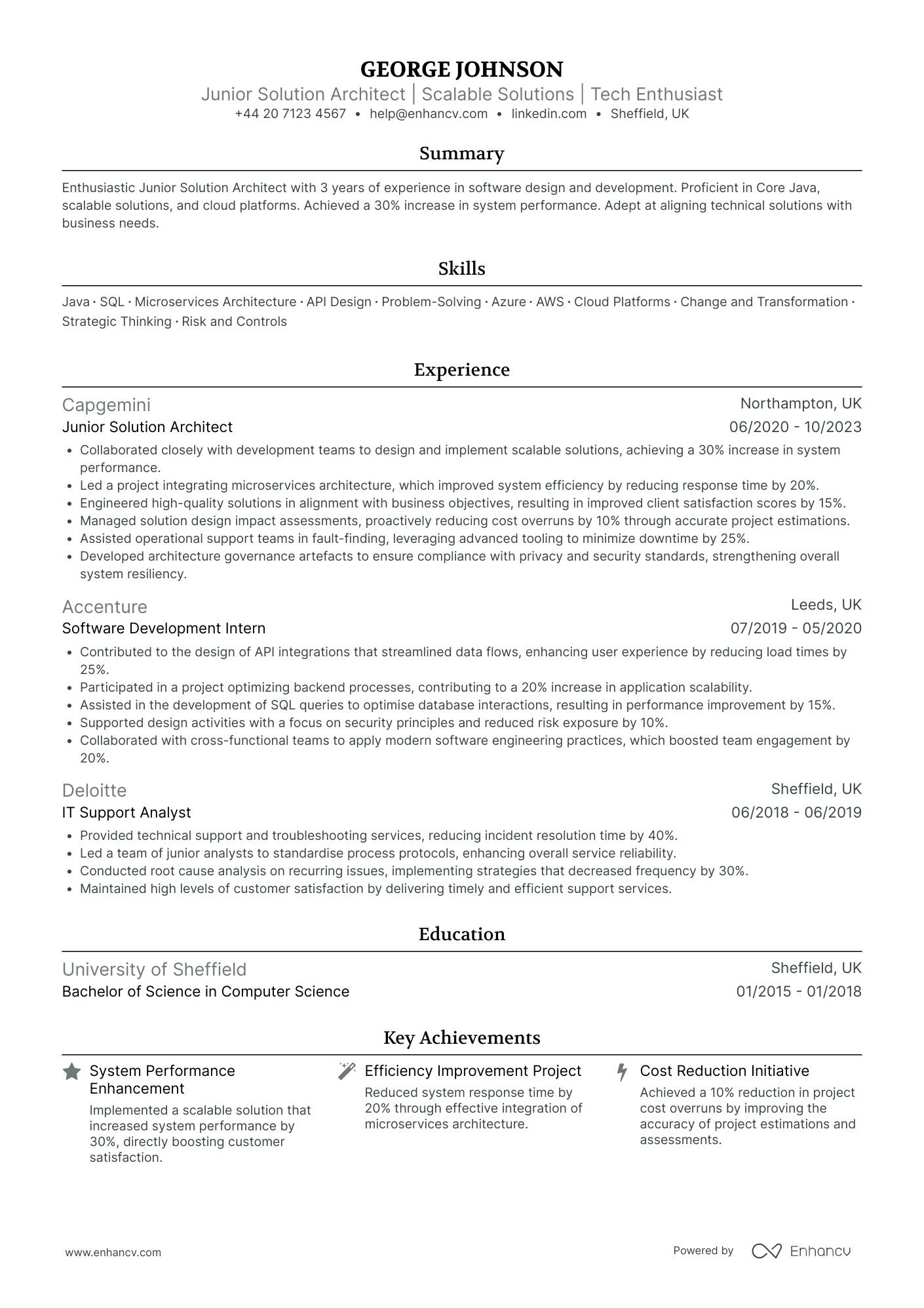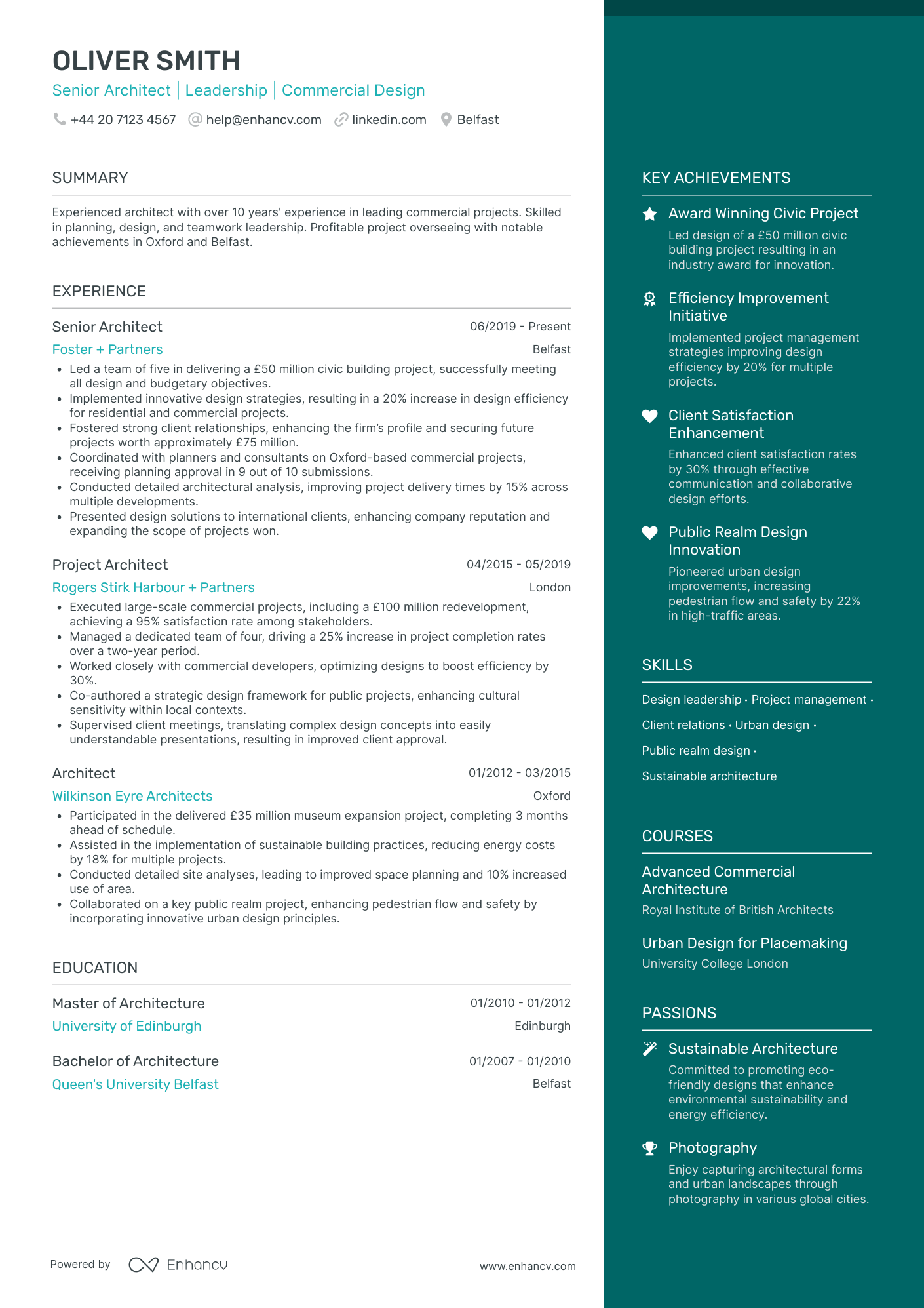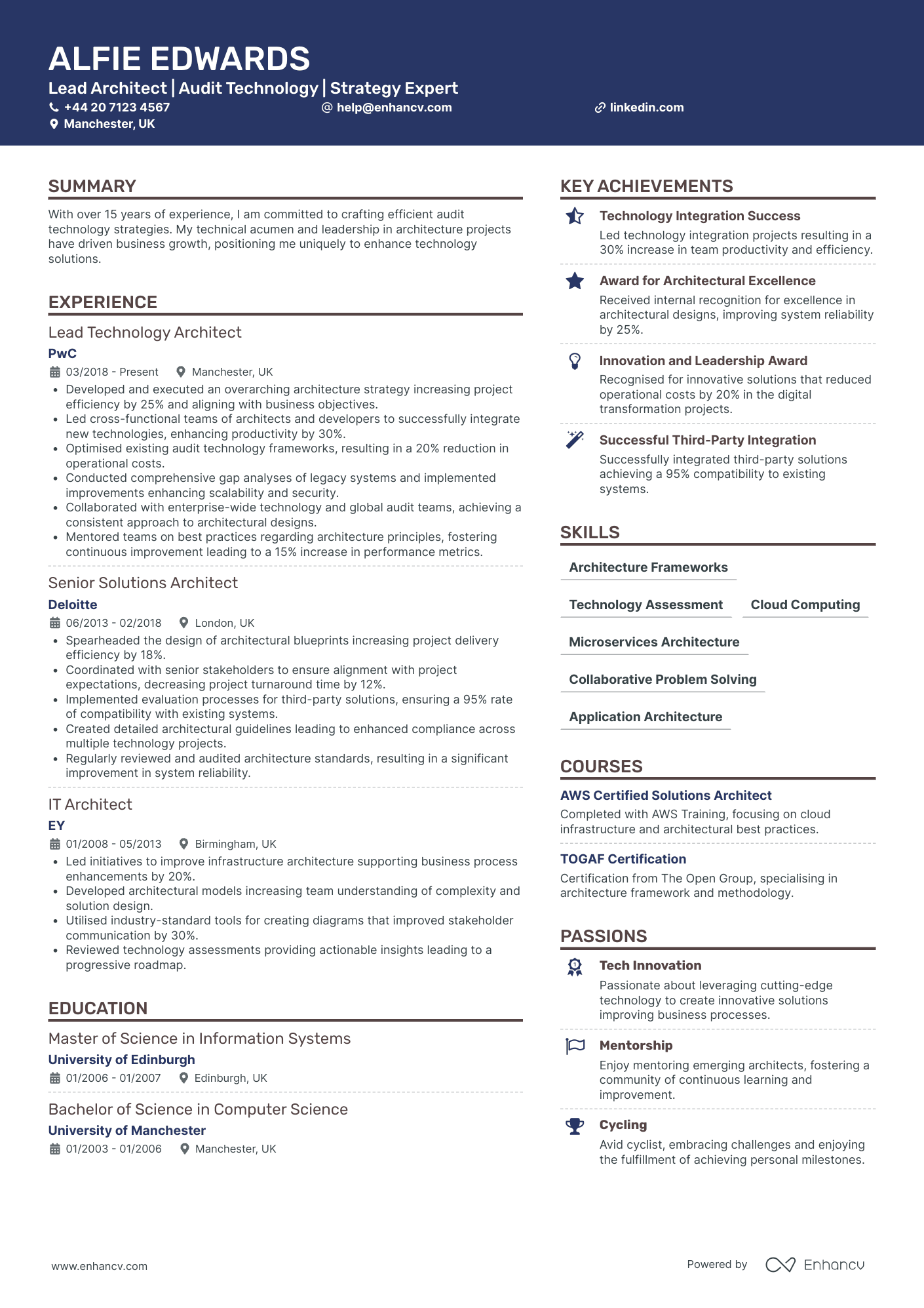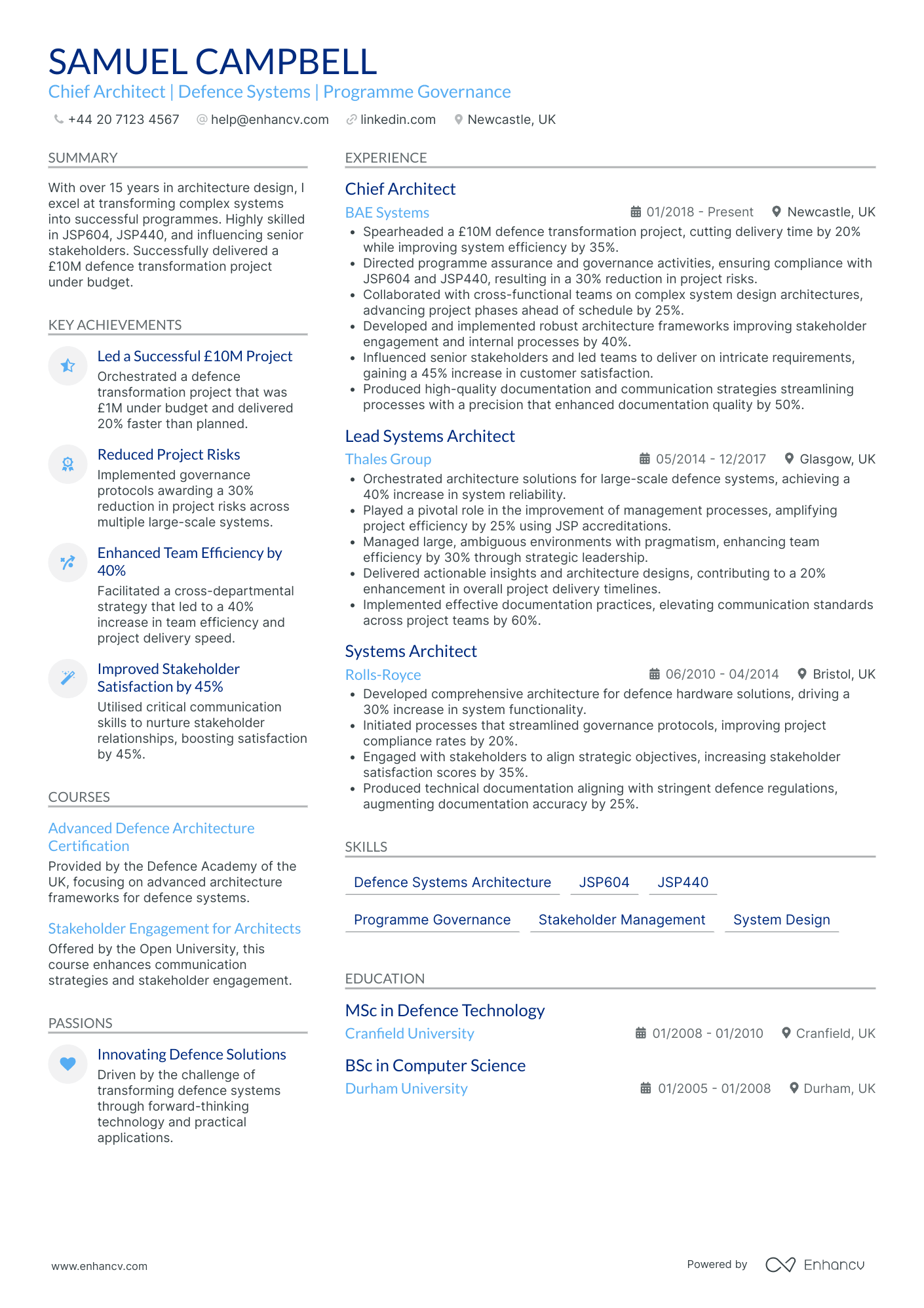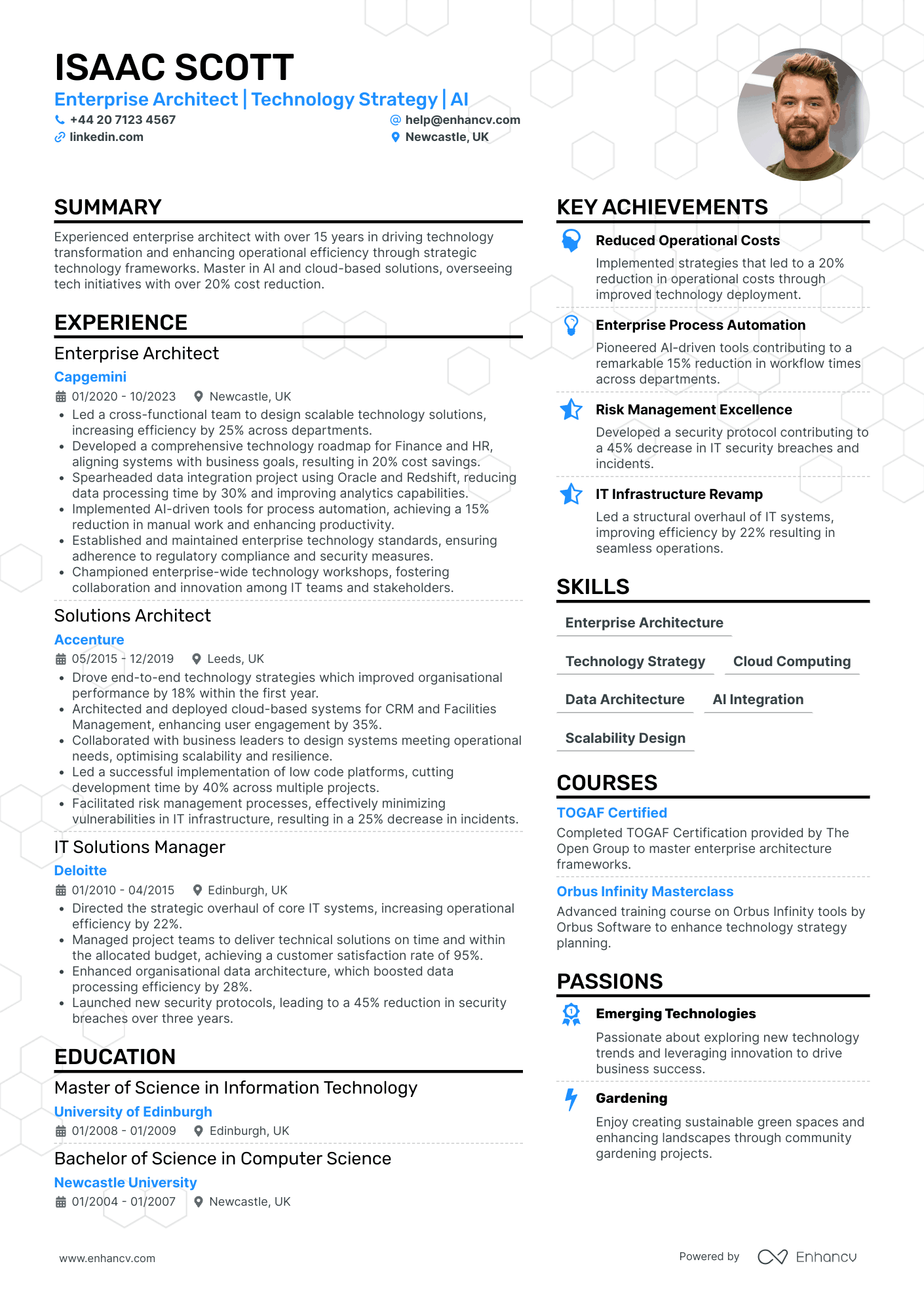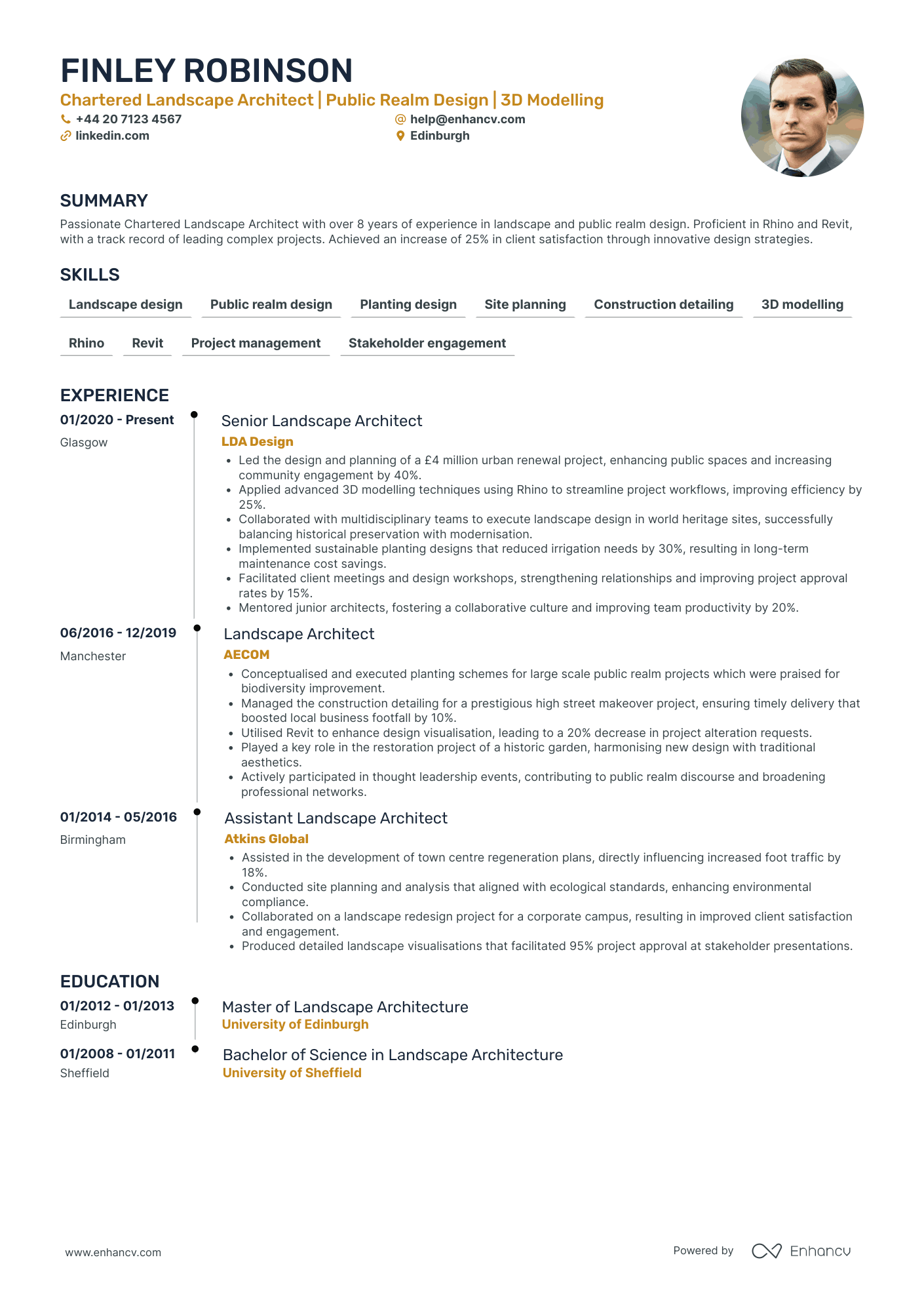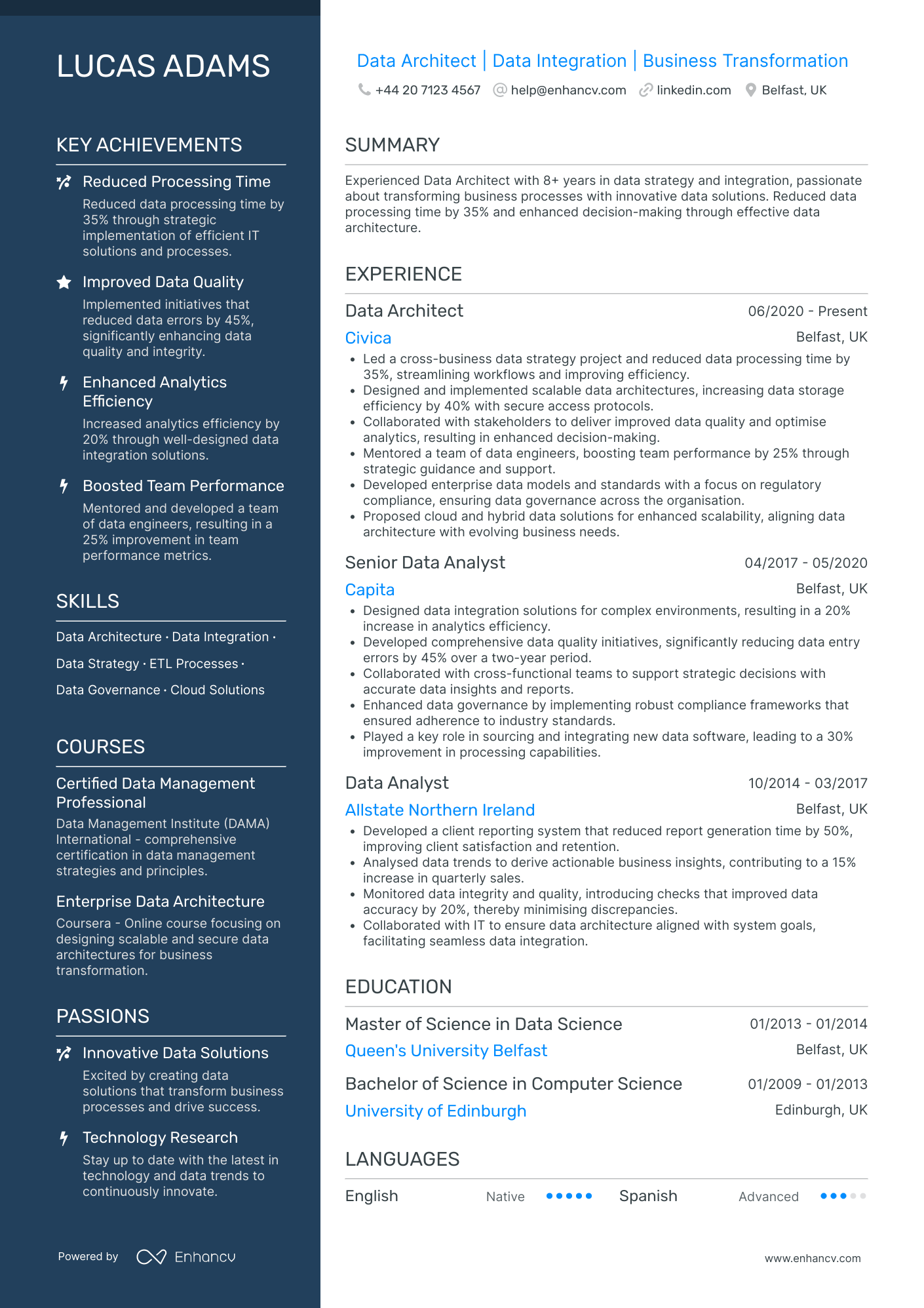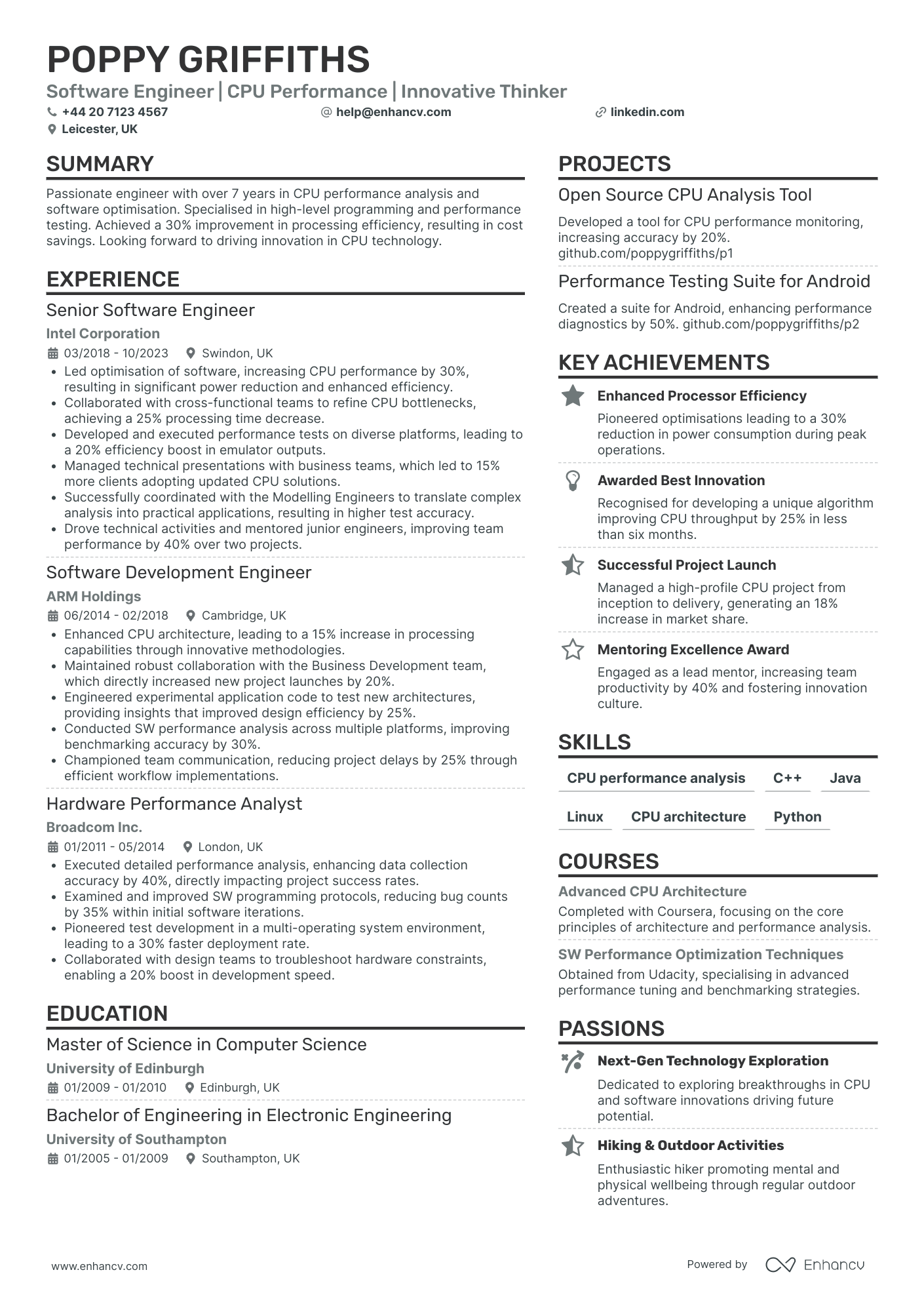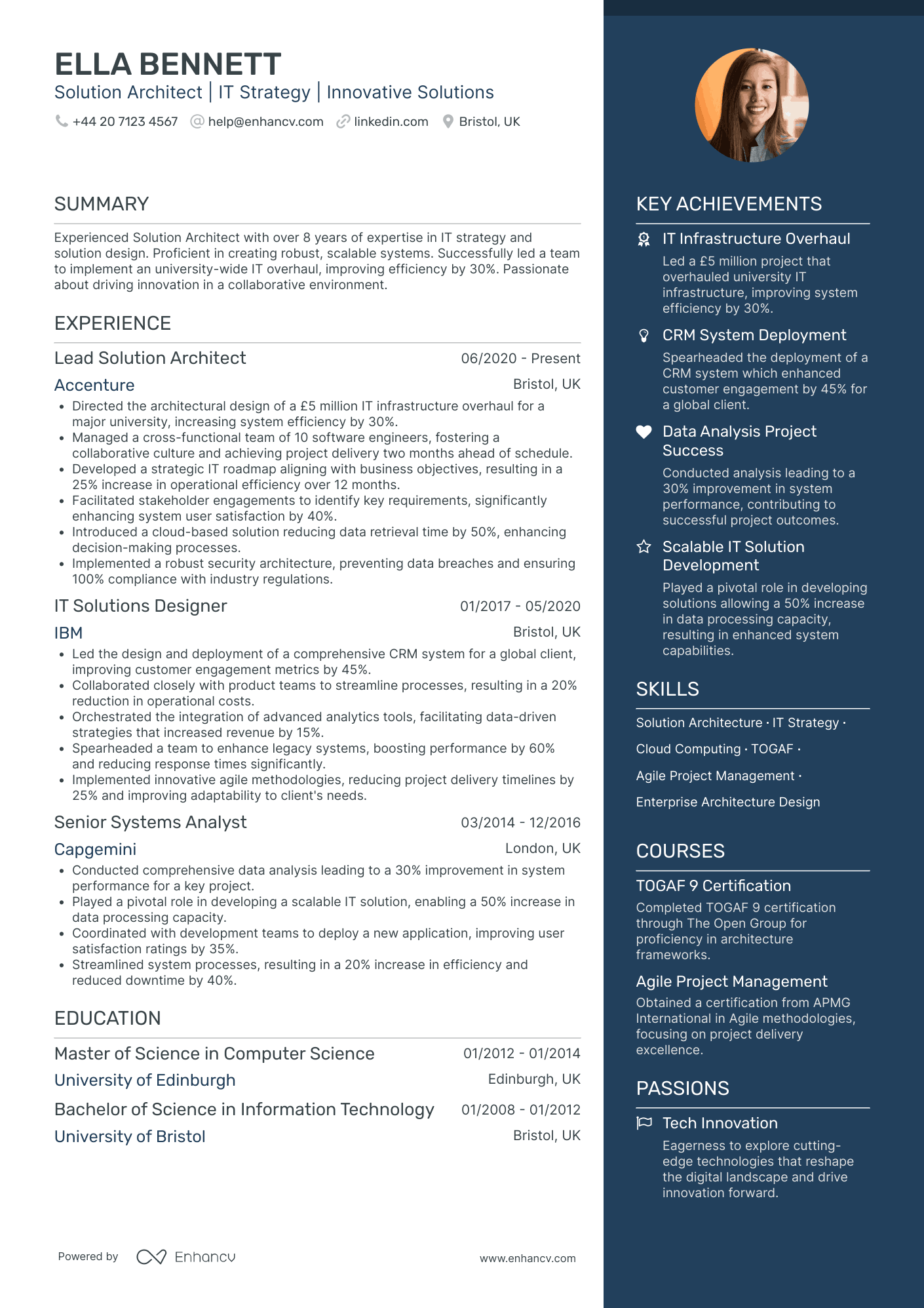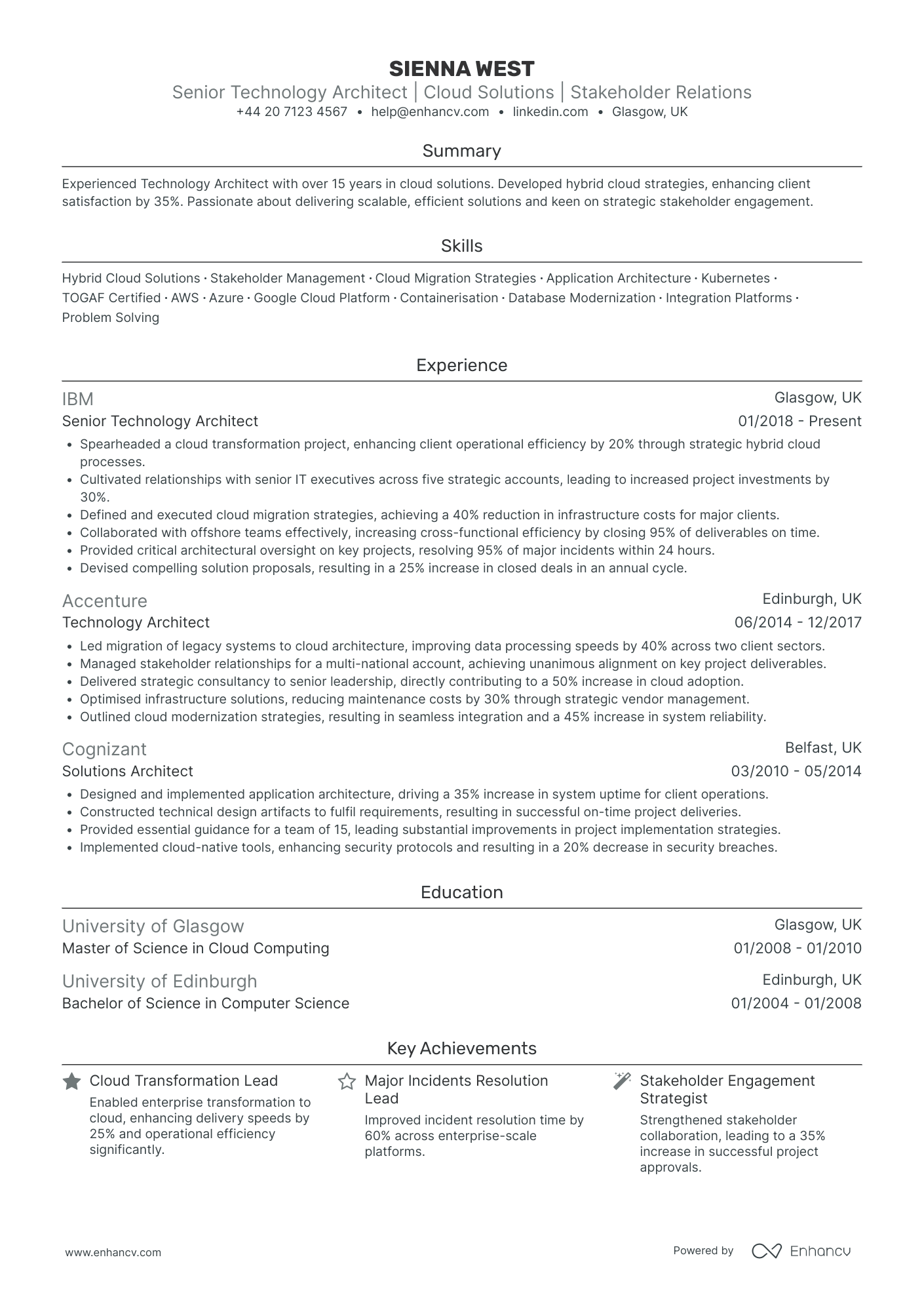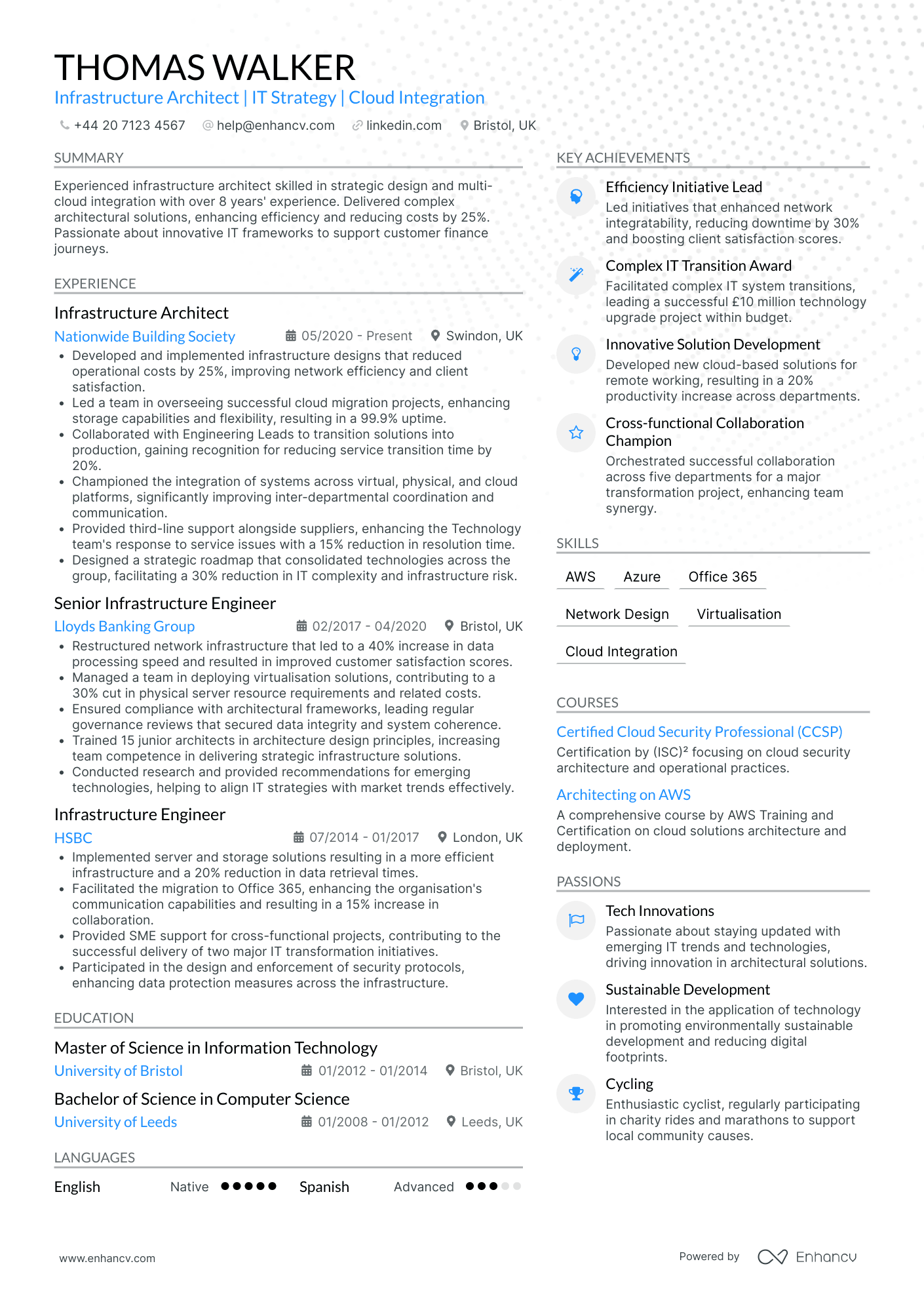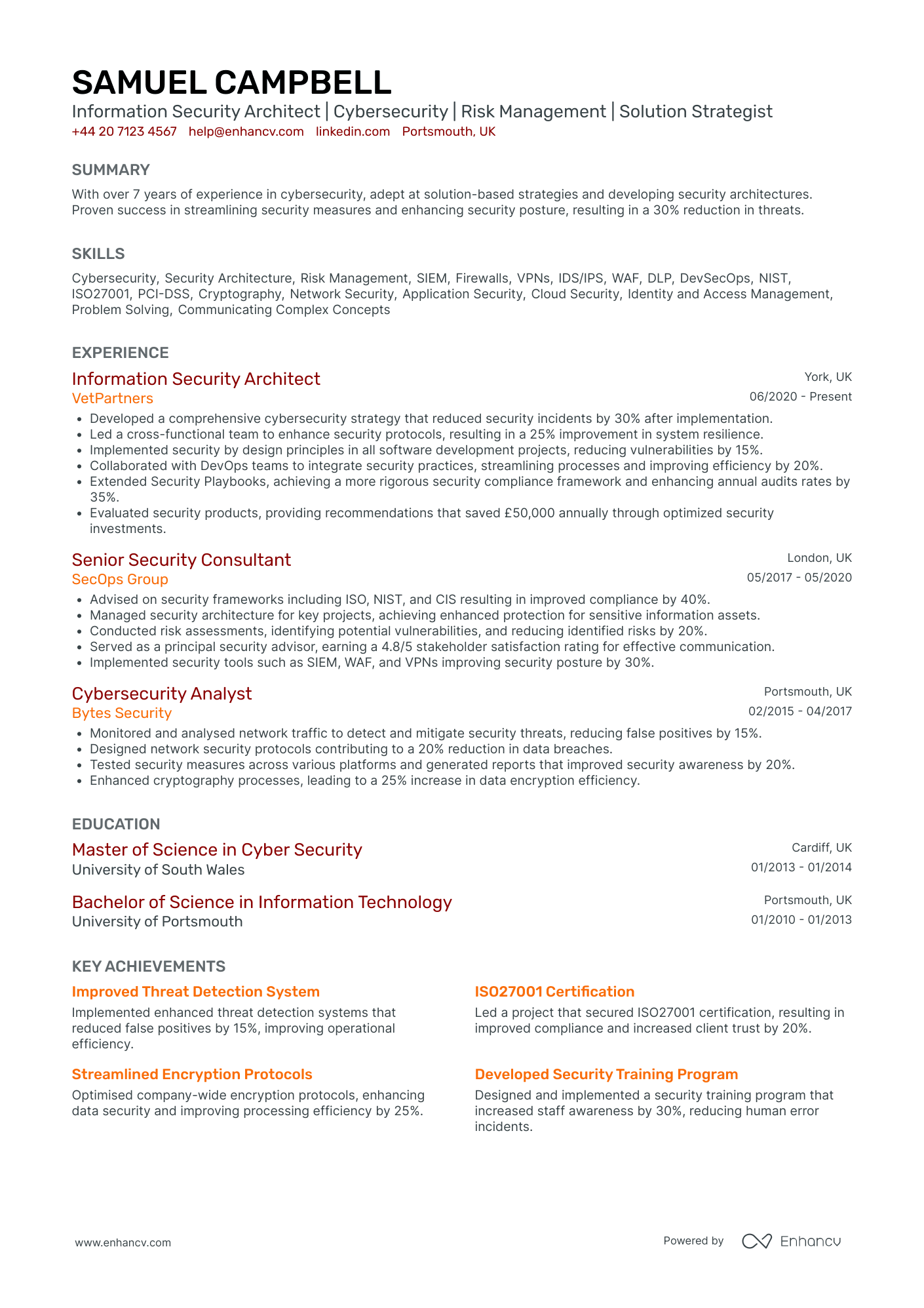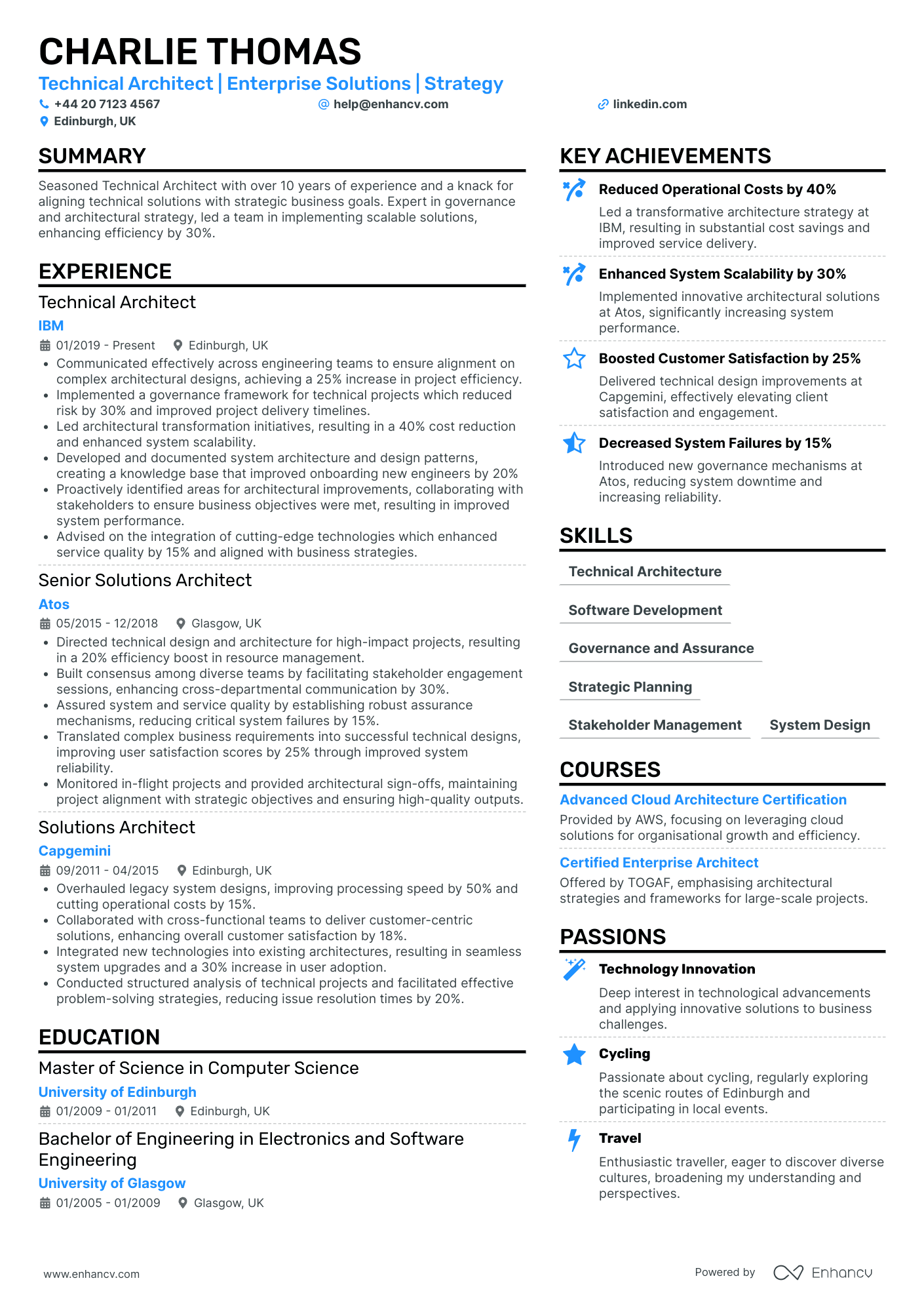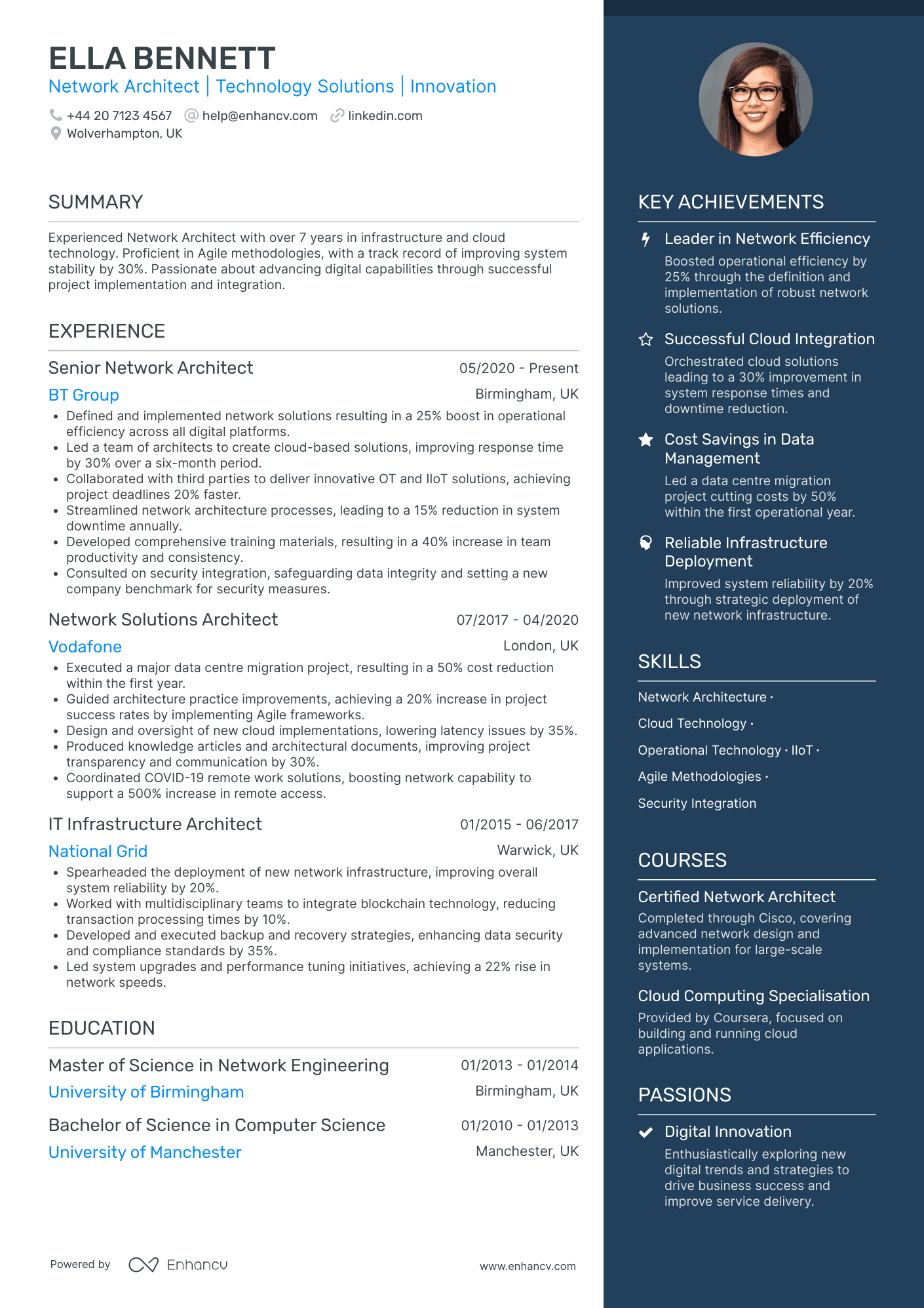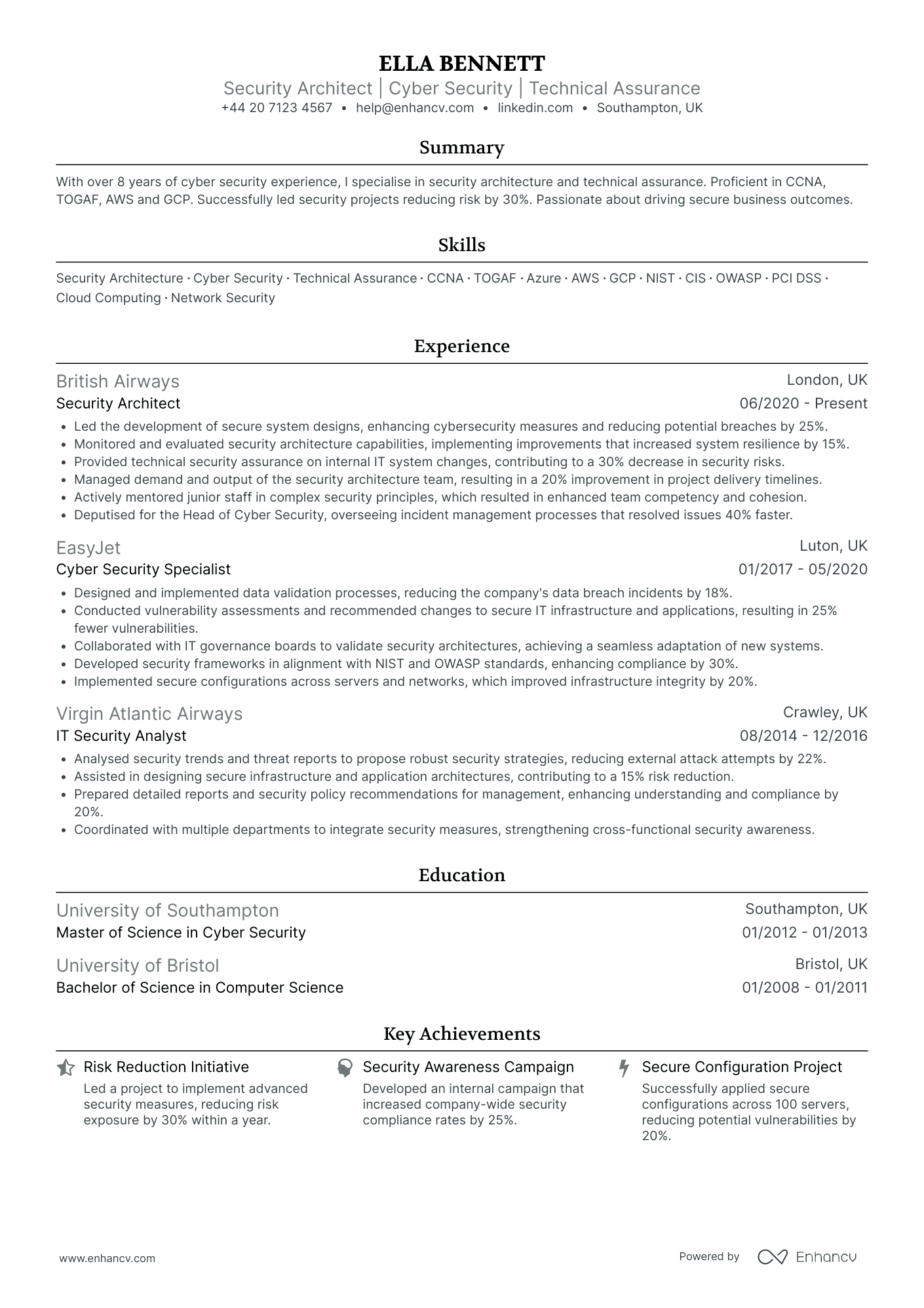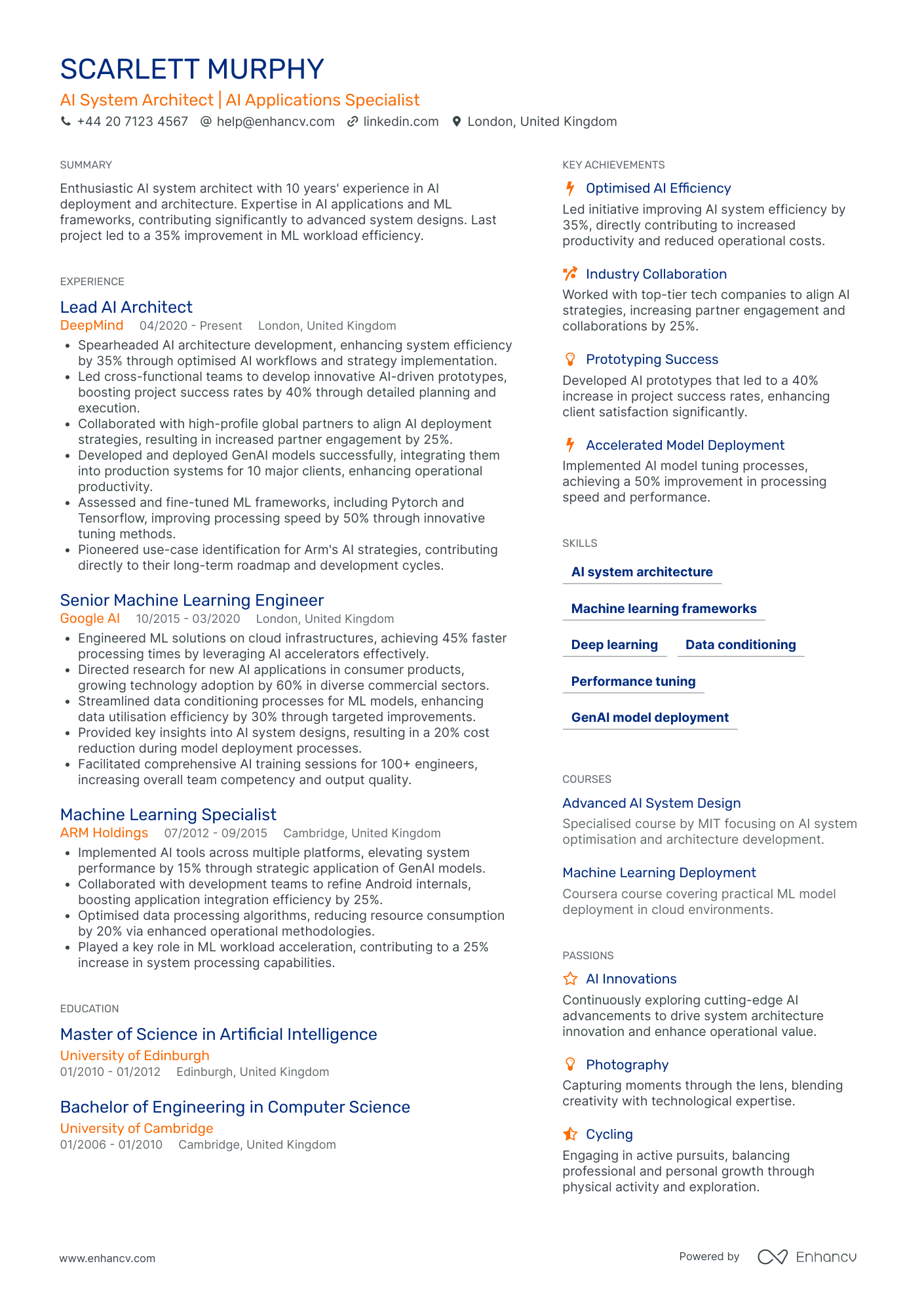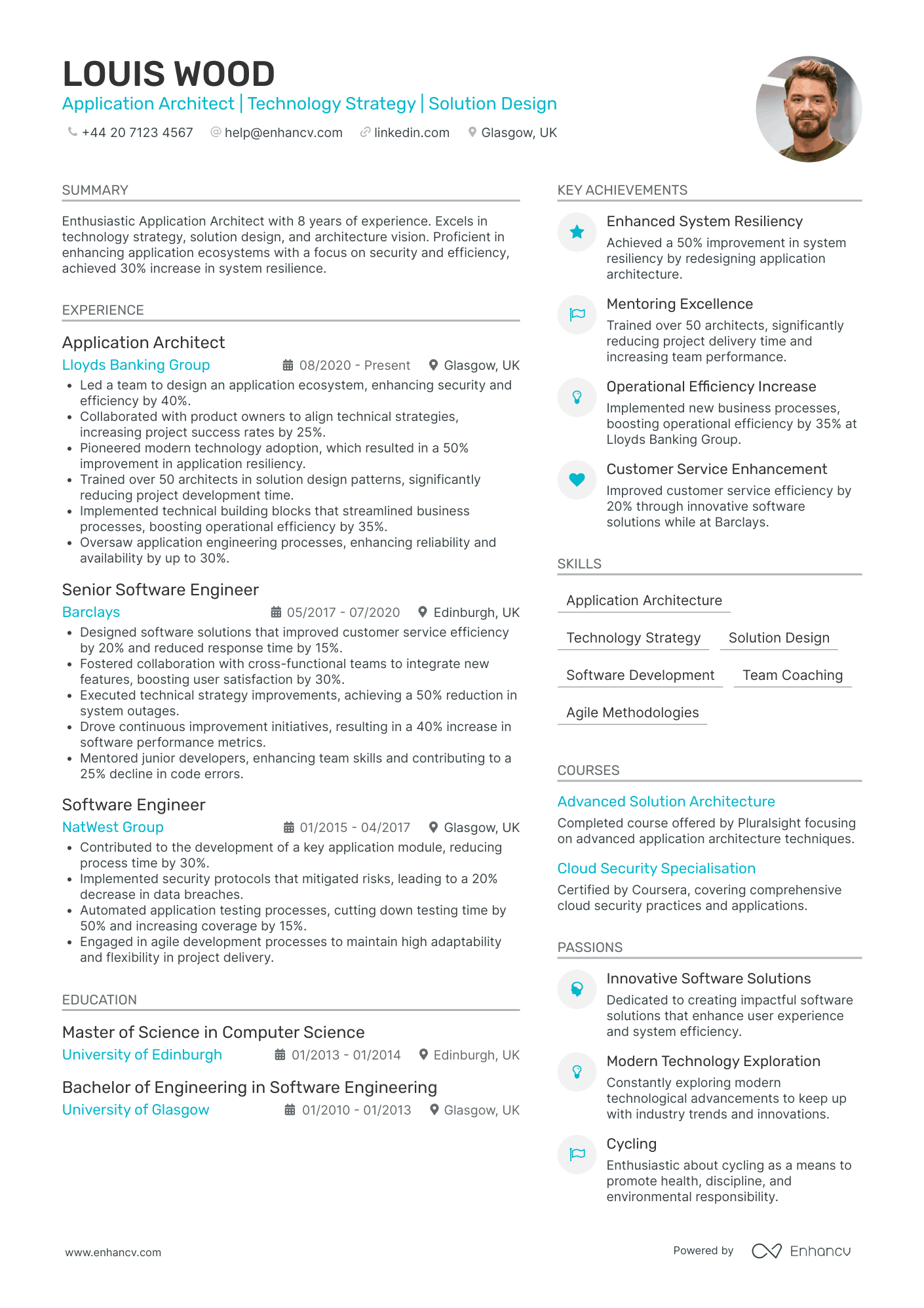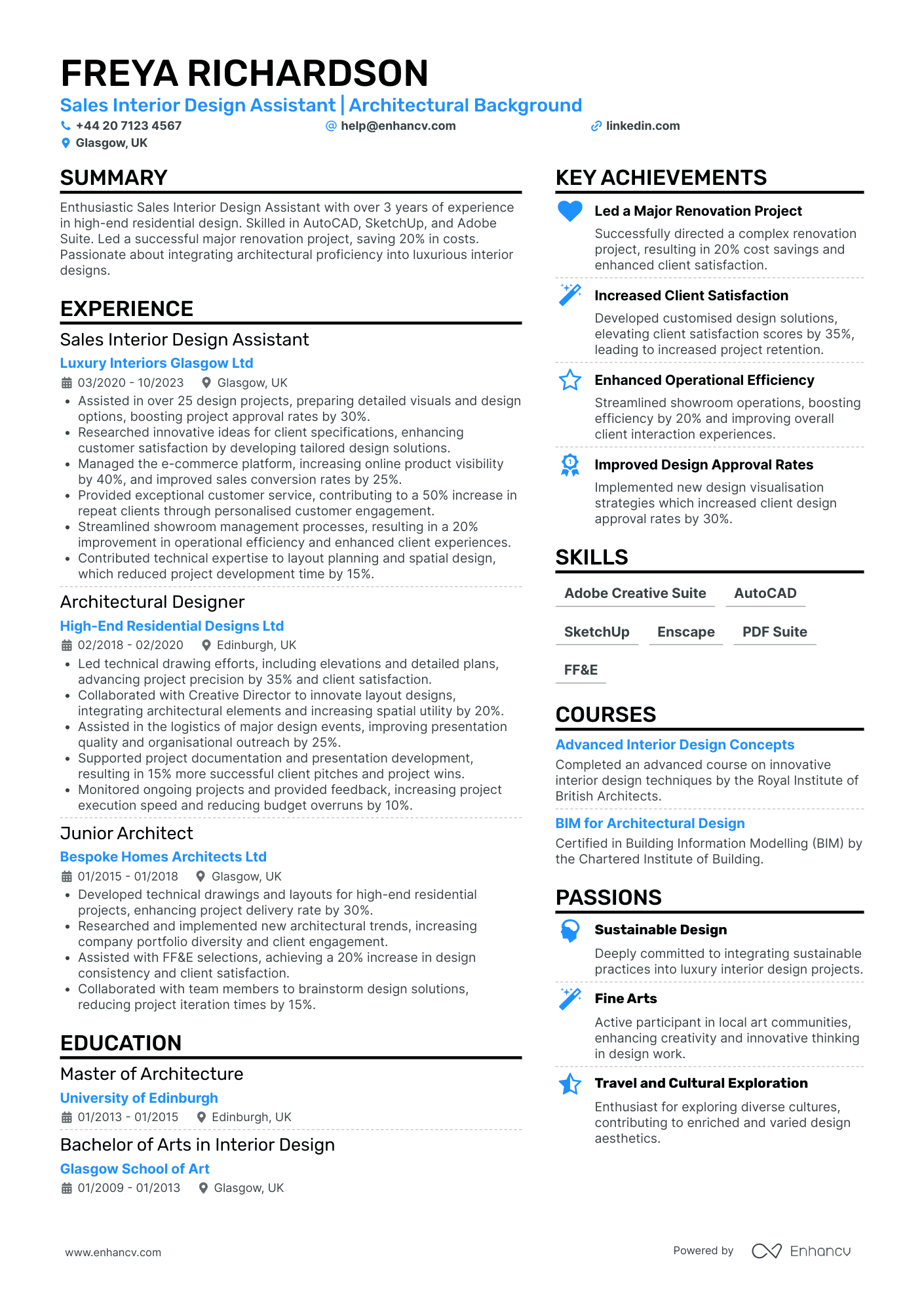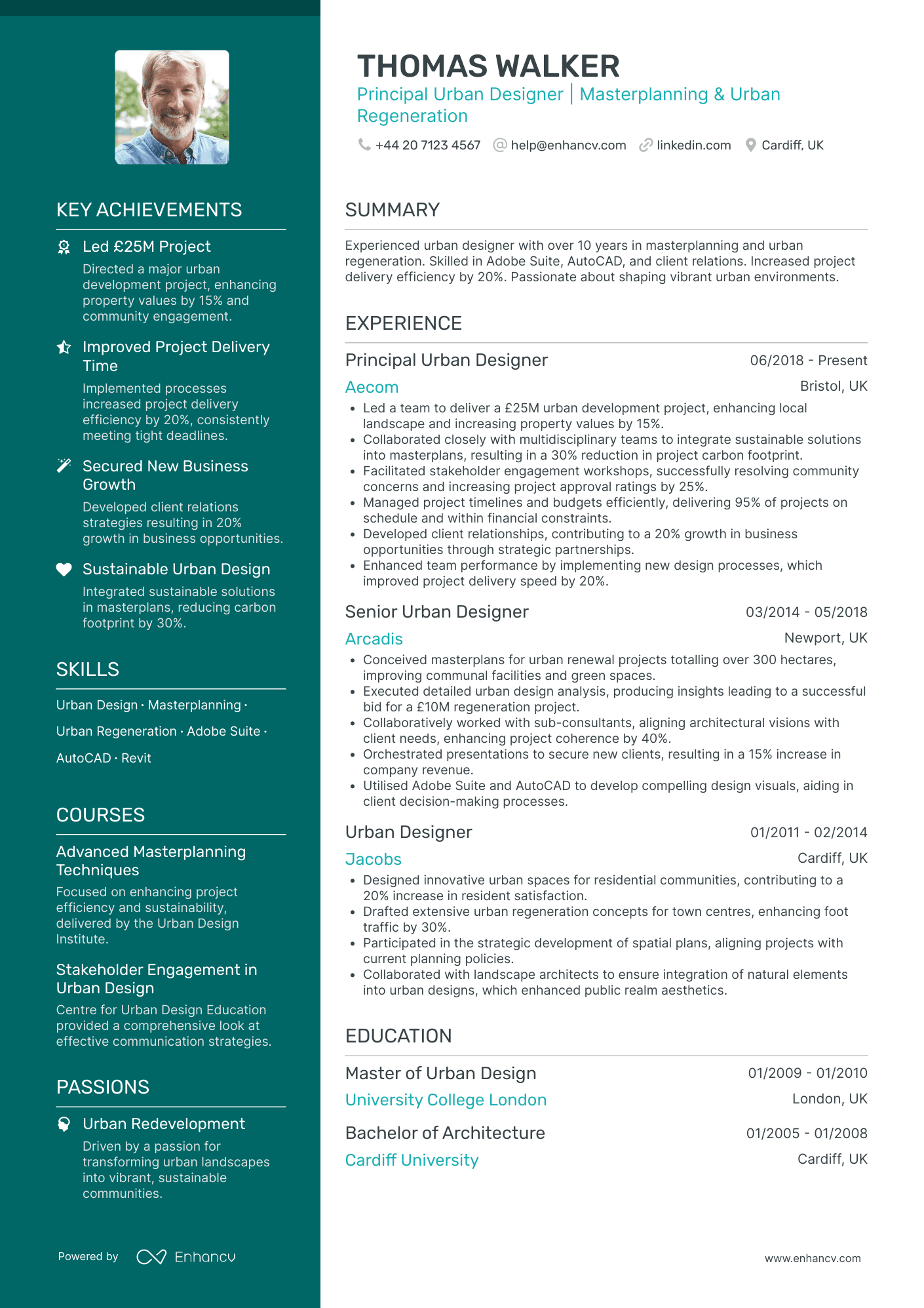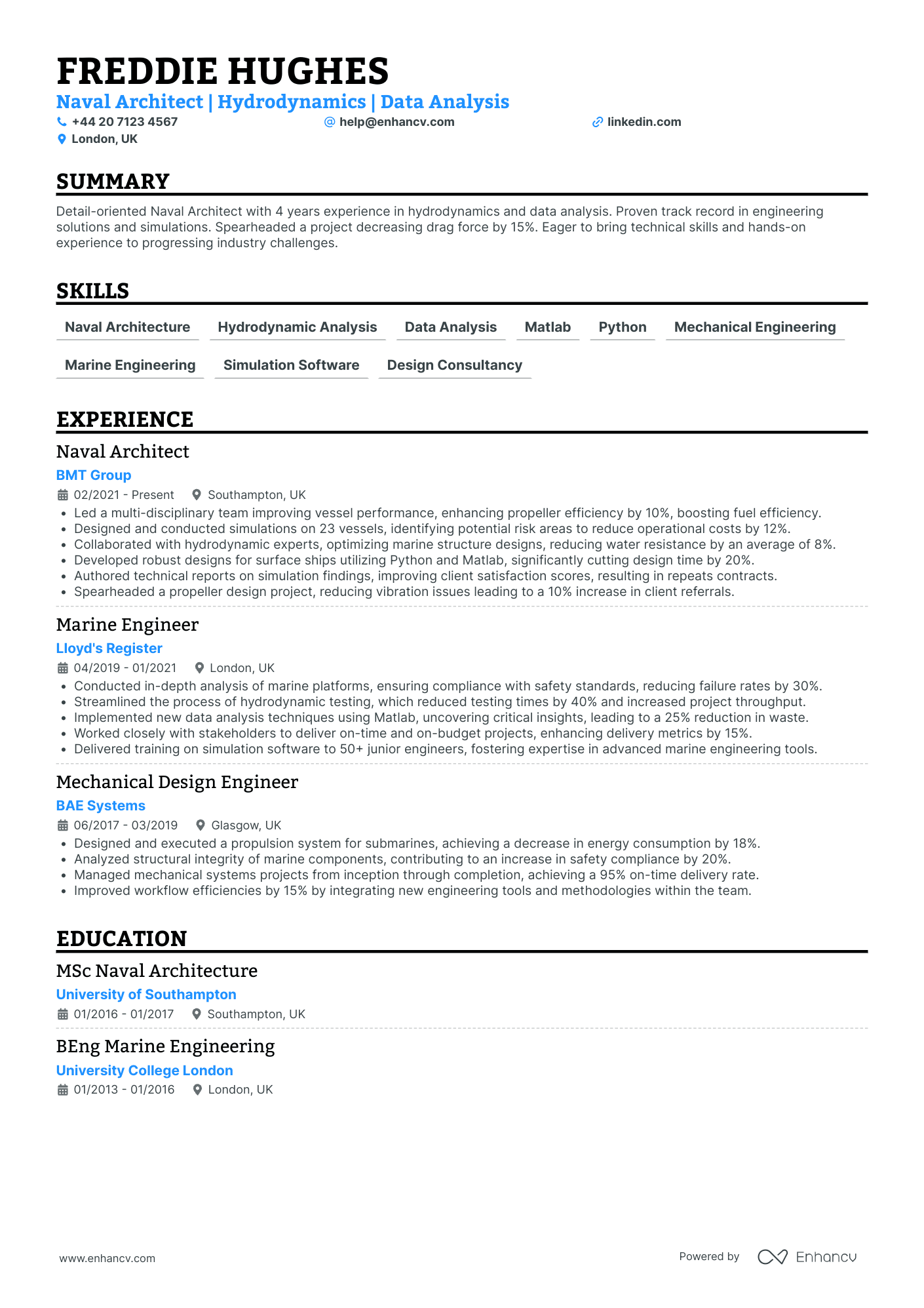One challenge faced by architects is effectively showcasing a diverse portfolio of projects within a limited space on a CV. Our guide provides tailored strategies to concisely present your work, ensuring you highlight your most impactful designs without overwhelming potential employers.
- Applying best practices from real-world examples to ensure your profile always meets recruiters' expectations;
- What to include in your work experience section, apart from your past roles and responsibilities?
- Why are both hard and soft skills important for your application?
- How do you need to format your CV to pass the Applicant Tracker Software (ATS) assessment?
If you're writing your CV for a niche architect role, make sure to get some inspiration from professionals:
Resume examples for architect
By Experience
Junior Architect
- Structured and Concise Presentation - The CV is neatly structured, offering clear sections that make it easy to comprehend the candidate's qualifications and experience. The use of bullet points facilitates quick reading and highlights key achievements and responsibilities effectively.
- Impressive Career Trajectory and Growth - George's progression from an IT Support Analyst to a Junior Solution Architect at a reputable firm like Capgemini showcases his career growth. This trajectory reflects his increasing responsibilities and expertise in scalable solutions and software design, which are vital for his role.
- Unique Technical Depth and Methodology Complement - The CV emphasizes George’s proficiency in industry-specific tools like Java, SQL, and cloud platforms such as Azure and AWS, along with modern methodologies like microservices architecture. His hands-on experience with these technologies demonstrates strong technical depth relevant to solution architecture.
Senior Architect
- Clear Content Structure and Clarity - The CV is impressively structured, offering a concise yet comprehensive overview of Oliver Smith’s qualifications. Each section is succinct, separating complex roles and achievements into digestible bullet points for easy readability. The use of clear headings for experience, education, skills, courses, achievements, languages, and passions provides a complete picture of his professional landscape.
- Progressive Career Trajectory - Oliver’s career shows a defined path of growth, with progressive roles that include advancing from an Architect to a Senior Architect. This trajectory demonstrates not only his evolving expertise in architecture but also his ability to take on increased responsibility, evident by his leadership role at Foster + Partners where he manages significant budgetary projects.
- Impactful Achievements with Business Relevance - The CV communicates achievements not just through numbers but by contextualizing them within broader business impacts. For example, the increase in design efficiency, client satisfaction, and pedestrian flow are presented alongside the financial or operational improvements they caused, such as securing future projects worth millions and enhancing safety in high-traffic areas.
Lead Architect
- Strategic Leadership and Mentorship - The CV emphasizes Alfie Edwards' role as a strategic leader, with experience mentoring teams to enhance architectural principles, thus fostering continuous improvement. This showcases his ability to lead and inspire within cross-functional teams, aligning technical activities with overarching business strategies.
- Diverse Technical Proficiency - Crafted with a focus on technology, the resume outlines specific expertise in architecture frameworks and tools such as AWS, Azure, and TOGAF. Alfie demonstrates adaptability to evolving technology landscapes and mastery in applying these tools effectively across different projects to enhance scalability and security.
- Impact-driven Achievements - The CV presents a strong case with achievements linked to business impact, showcasing numerous instances like optimizing audit technologies to reduce costs by 20% and enhancing productivity by up to 30%. These figures not only demonstrate technical success but also underline strategic improvements, solidifying his reputation as a driver of growth and efficiency.
Chief Architect
- Structured and Concise Presentation - The CV is organized with a clear structure that highlights the candidate's progression through their career. Each section is well-labeled, making it easy for the reader to navigate and understand the crucial details promptly, which is particularly valuable in the competitive field of defence systems architecture.
- Detailed Career Growth - Samuel Campbell's career trajectory reflects steady growth in responsibility and scope, from Systems Architect roles in prominent companies like Rolls-Royce and Thales Group to his current position as Chief Architect at BAE Systems. Each role showcases an increase in leadership and the complexity of projects managed, illustrating a robust and ascending career path.
- Focus on Industry-Specific Skills - The CV emphasizes Samuel's expertise in defence-related methodologies with mention of specific frameworks such as JSP604 and JSP440. These are critical for programme governance in the defence industry and highlight his in-depth technical knowledge and ability to comply with stringent industry standards.
By Role
Enterprise Architect
- Strategically Aligns Technology with Business Goals - Isaac Scott’s CV clearly highlights his ability to develop comprehensive technology roadmaps that align IT systems with core business objectives. His strategic vision is evidenced by his work at Capgemini, where he led tech initiatives resulting in substantial cost savings and enhanced operational efficiency, demonstrating his savvy in harmonizing technology deployment with business strategy.
- Diverse Experience Across Industries and Roles - The breadth of Scott's career showcases a trajectory that spans reputable firms like Capgemini, Accenture, and Deloitte. His progression from IT Solutions Manager to Enterprise Architect underscores a steady climb up the IT leadership ladder, indicating his capability to adapt and thrive in different sectors and company cultures. This advancement reflects his competence in embracing and leveraging industry shifts while staying at the forefront of technology strategy.
- Deep Technical Expertise Coupled with Leadership - Holding certifications like TOGAF and engaging in masterclasses such as the Orbus Infinity Masterclass, Scott demonstrates a high degree of technical depth and a commitment to continuous professional development. Furthermore, his record of leading cross-functional teams and fostering innovation through corporate workshops speaks to his soft skills and leadership abilities, which are critical for driving enterprise-wide IT transformations.
Landscape Architect
- Structured Presentation and Clarity - The CV is exceptionally well-organized, starting with a succinct summary that sets the stage for the candidate's credentials. Each section is clearly labeled, ensuring that key skills, achievements, and experiences are easy to navigate and comprehend, presenting a highly professional appearance.
- Career Trajectory and Professional Growth - Finley Robinson displays a clear upward career path, from an assistant landscape architect to a senior role, demonstrating a steady progression with increasing responsibilities. The movement between prestigious firms like LDA Design, AECOM, and Atkins Global highlights a robust career in landscape architecture across different project sizes and challenges.
- Technical Proficiency with Industry-Specific Tools - A standout aspect of this CV is the emphasis on technical skills, notably the proficiency in 3D modelling using Rhino and Revit. This specialized knowledge underscores the candidate's ability to lead and enhance complex projects, emphasizing their significance in modern landscape architecture.
Data Architect
- Clear, Structured Presentation - The CV is organized in a clear, structured manner, making it easy to navigate through John Doe's professional journey. Each section is well-defined, including a concise summary, detailed experiences, and education, which facilitates quick comprehension of his qualifications and achievements.
- Diverse Career Trajectory - John Doe's progression from Data Analyst to Data Architect showcases significant professional growth. His career path reflects an increasing level of responsibility and expertise, indicating a strong potential for leadership and a deep understanding of data architecture and integration.
- Strategic Achievements with Business Impact - The achievements listed, such as reducing data processing time by 35% and enhancing team performance by 25%, not only quantify the impact of John Doe's contributions but also illustrate his ability to drive significant business transformations through strategic data management practices.
Software Architect
- Clear and Structured Content Presentation - The CV's clarity and structure effectively highlight Poppy Griffiths' qualifications and career. Each section is well-organized, offering concise overviews of roles, achievements, and skills. Bullet points under job experiences succinctly convey key responsibilities and accomplishments, ensuring readability and quick comprehension of the candidate's capabilities.
- Strong Career Trajectory in CPU Performance - Poppy Griffiths' career path shows a clear trajectory of growth, advancing from a Hardware Performance Analyst to a Senior Software Engineer at Intel Corporation. This progression reflects her increasing responsibility and impact in the industry. Additionally, her movement through prominent companies like ARM Holdings and Intel demonstrates her dynamic adaptability and commitment to professional development in CPU performance.
- Achievement with Significant Business Impact - The CV effectively communicates the tangible business impacts of Poppy's achievements. For instance, her work in enhancing CPU performance has led to substantial improvements in processing efficiency and reduction in power consumption, resulting in cost savings and increased market share for her employers. These outcomes highlight not only her technical expertise but also her ability to deliver results that align with broader business objectives.
Solutions Architect
- Structured and Clear Presentation - Ella Bennett’s CV is exceptionally well-organized, presenting information clearly and concisely. Each section is distinctly outlined, enabling easy navigation for readers. Key accomplishments are highlighted with bullet points, making significant achievements easily identifiable and digestible.
- Consistent Career Progression - The CV demonstrates a logical career trajectory with progressive roles within top-tier consulting firms such as Accenture, IBM, and Capgemini. Each role showcases a clear increase in responsibility and leadership, reflecting a successful career advancement from a Senior Systems Analyst to a Lead Solution Architect.
- Emphasis on Soft Skills and Leadership - Aside from technical expertise, the CV highlights important soft skills such as stakeholder engagement, team collaboration, and strategic leadership. Ella's experience in managing cross-functional teams and fostering a collaborative working environment is noted, underscoring critical traits necessary for a Solution Architect.
Cloud Solutions Architect
- Clear and Structured Content Layout - The CV is organized in a manner that prioritizes readability and clarity, using distinct headings and subheadings for each section. The structured approach allows potential employers to quickly skim for relevant information, ensuring key skills and experiences are easily accessible.
- Dynamic Career Trajectory - The candidate's career trajectory demonstrates impressive growth, with consistent promotions and expansions in responsibilities. This progression is indicative of their ability to adapt and excel in varying roles, and it showcases a trajectory from entry-level positions to higher leadership roles within the IT consulting sector.
- Industry-Specific Technical Expertise - Highlighted within the CV are specific tools and methodologies pertinent to software development and IT project management. Proficiency in Agile methodologies, alongside deep technical expertise in programming languages like Python and Java, underscores the candidate's technical depth and alignment with industry standards.
Infrastructure Architect
- Clear and Structured Presentation - The CV is presented with excellent clarity and structure, making it easy to navigate. Each section is clearly defined, with concise bullet points allowing quick insights into key responsibilities and achievements. This clarity ensures that the reader can quickly understand the candidate's background and areas of expertise.
- Demonstrated Career Growth and Industry Expertise - Thomas Walker’s career trajectory indicates a steady growth path, moving from an Infrastructure Engineer to Senior Infrastructure Engineer, and finally to Infrastructure Architect. This progression showcases his deepening expertise in IT strategy and cloud integration, underscoring a strong foundation in both technical and managerial roles within prominent financial institutions.
- Impactful Achievements with Business Relevance - The CV highlights achievements with significant business impacts, such as the reduction of operational costs by 25% and improvement in network efficiency and uptime. These metrics are not just numbers, but they demonstrate the candidate’s capability to deliver solutions that align IT initiatives with business goals, enhance operational capabilities, and improve customer satisfaction.
Information Architect
- Succinct and Structured Presentation - The CV is presented with a clear and organized structure, making it easy for a reader to navigate through the various sections. Each section, from the professional summary to the detailed achievements, is concise and focused, ensuring that the most relevant information is highlighted quickly and effectively.
- Progressive Career Development - The career trajectory of Samuel Campbell demonstrates significant growth and progression within the cybersecurity field. Starting as a Cybersecurity Analyst and advancing to roles like Senior Security Consultant and Information Security Architect, his career path reveals a natural progression of increased responsibility and expertise, as well as geographical workplace diversity from Portsmouth to London to York.
- Industry-Specific Tools and Methodologies - The CV showcases a deep technical proficiency with industry-standard tools such as SIEM, WAF, and VPNs, alongside methodologies like security by design and DevSecOps. These elements are crucial for a cybersecurity professional and reflect an adeptness in implementing sophisticated security solutions that are tailored to specific organizational needs.
Technical Architect
- Strategic Leadership and Vision - The CV thoroughly underscores Charlie Thomas's ability to lead transformative projects by aligning technical solutions with strategic business goals. This is evident in the diverse leadership roles he’s undertook, where he delivered significant cost reductions and enhanced scalability, demonstrating his strategic foresight and effective leadership capabilities.
- Diverse Industry Experience and Growth - Charlie's career trajectory is notably impressive, moving from a Solutions Architect at Capgemini to a Senior Solutions Architect at Atos, and finally advancing to Technical Architect at IBM. This progression not only shows growth but indicates versatility across different organizational cultures and industries, enhancing his adaptability to various enterprise environments.
- Strong Governance Focus and Risk Mitigation - Through Charlie's CV, there is a clear emphasis on governance and assurance frameworks, with achievements in reducing risk by 30% and decreasing system failures by 15%. Such accomplishments highlight his skill in implementing robust governance structures that lead to more reliable and efficient organizational practices.
Network Architect
- Clear and Structured Presentation - Ella Bennett's CV is remarkably organized, presenting information in a structured and concise manner. The use of bullet points under each section allows for easy reading and quick identification of key achievements and skills, making it an efficient document for hiring managers to assess her qualifications.
- Impressive Career Growth and Industry Involvement - Ella has shown significant career progression, moving from an IT Infrastructure Architect to a Senior Network Architect within a few years. Her roles at prominent companies like BT Group, Vodafone, and National Grid showcase her ability to adapt and excel within the telecommunications sector, reflecting a robust career trajectory.
- Achievement-Oriented Narrative with Business Impact - The CV is rich in achievements that are not just quantitative but also business-relevant. For instance, Ella's leadership in projects that improved operational efficiency by 25% and reduced costs by 50% demonstrates her capability to drive substantial business results through strategic initiatives.
Security Architect
- Structured clarity in presentation - The CV is well-organized with a clear and concise structure, effectively showcasing Ella Bennett's extensive experience and qualifications. Each section is delineated with relevant details, making it easy to grasp the scope of her expertise without unnecessary information.
- Progressive career trajectory in cybersecurity - Bennett demonstrates significant career growth, marked by her progression from an IT Security Analyst to a Security Architect. Her experience across major airlines highlights her evolution in the cybersecurity industry and her increasing responsibilities in leadership and specialized roles.
- Industry-specific technical proficiency - The CV highlights unique elements such as proficiency in TOGAF, AWS, and GCP, along with certifications like CCNA and CISSP. These details underscore her deep technical expertise and relevance in the cybersecurity landscape, enhancing her capability to manage large-scale security architectures.
System Architect
- Clear and Structured Presentation - The CV is impressively organized, with well-defined sections that clearly highlight Scarlett Murphy's career achievements and expertise. Each section is concise and focused, with bullet points that neatly present quantifiable impacts and responsibilities.
- Strong Career Trajectory - Scarlett Murphy's career path demonstrates notable growth, with progressive roles from Machine Learning Specialist to Lead AI Architect within prominent companies like DeepMind and Google AI, showcasing her upward trajectory and increasing responsibilities in the AI field.
- Demonstrated Business Impact - The CV effectively presents achievements with significant business relevance, such as a 35% improvement in ML workload efficiency and a 25% increase in partner engagement, illustrating the direct impact her contributions have had on enhancing productivity and strategic collaborations.
Application Architect
- Strategic Career Advancement - Louis Wood's CV showcases a clear trajectory of growth and responsibility from a Software Engineer at NatWest Group to an Application Architect at Lloyds Banking Group. This progression highlights his commitment to increasing complexity in roles, emphasizing his strategic and leadership capabilities within the banking sector.
- Depth in Technical Expertise and Methodologies - The CV reflects a robust understanding of cutting-edge technologies, from modern technology adoption enhancing application resiliency to employing solution design patterns in training. His expertise in system resiliency and security protocols positions him as highly knowledgeable in maintaining and improving the technological infrastructure.
- Significant Achievements with Quantifiable Business Impact - Louis Wood's contributions are made evident through measurable successes, such as a 40% enhancement in security and efficiency and a 50% improvement in system resiliency. His achievements, like enhancing customer service efficiency and boosting operational processes, demonstrate a strong alignment with business goals and value addition to organizations.
Interior Design Architect
- Well-structured presentation with a focus on results - The CV uses a clear and logical structure, beginning with a concise summary that spotlights Freya’s expertise in combining sales, interior design, and architecture. Each experience section is crafted to emphasize quantifiable achievements, providing strong evidence of her effectiveness in roles related to design and client satisfaction.
- Career progression demonstrating industry evolution - Freya’s career trajectory is indicative of a deliberate progression from a Junior Architect to a pivotal role as a Sales Interior Design Assistant. This path shows a shift from pure architectural focus to an integrative approach that merges design and client interaction, illustrating adaptability and growth potential in her field.
- Emphasis on utilizing industry-specific tools and innovative practices - The CV highlights Freya’s adeptness with vital tools such as AutoCAD, SketchUp, and Adobe Suite, reflecting her technical depth. It also showcases her involvement with the e-commerce platform and sustainable design practices, underscoring her commitment to integrating new technologies and methodologies for enhanced design solutions.
Urban Planner Architect
- Strong Leadership and Team Management - The CV effectively demonstrates Thomas Walker's leadership capabilities through his role as a Principal Urban Designer, where he successfully led a team to deliver significant urban development projects. It highlights his ability to manage project timelines, enhance team performance, and foster client relationships, illustrating his capability to drive both internal team success and external partnerships.
- Impressive Career Growth - The progression through roles from Urban Designer at Jacobs to Senior Urban Designer at Arcadis, and ultimately to Principal Urban Designer at Aecom, showcases a consistent trajectory of promotions and increasing responsibility. This trajectory underscores his growing expertise and impact within the urban design field, emphasizing a successful career path marked by professional advancement and achievement.
- Commitment to Sustainability and Innovation - Thomas's CV highlights a clear commitment to sustainability through his integration of eco-friendly solutions into masterplans, achieving significant reductions in carbon footprints by 30%. His use of advanced tools like Adobe Suite and AutoCAD for innovative design approaches further points to his dedication to cutting-edge urban regeneration, setting him apart as a forward-thinking professional in the industry.
Marine Architect
- Comprehensive yet concise structure - The CV is well-organized with each section clearly defined, offering a seamless flow of information from personal details down to specific achievements and courses. This clarity ensures easy navigation and quick access to key information relevant to potential employers. The use of bullet points for job responsibilities and achievements enhances readability and allows for quick scanning.
- Progressive career trajectory in naval architecture - Freddie Hughes showcases a clear career progression, moving from a Mechanical Design Engineer at BAE Systems to a Naval Architect at BMT Group, with each role demonstrating increasing responsibility and complexity. This trajectory indicates a focused and deliberate path in naval architecture and marine engineering, reflecting both ambition and capability in his field.
- Integration of specialized technical skills - The CV highlights Freddie Hughes's expertise in specialized tools and methodologies such as Python, Matlab, and advanced hydrodynamic simulation techniques. These skills are crucial in the naval architecture industry and underscore his technical depth and ability to leverage these tools for optimizing vessel design and performance.
How to ensure your profile stands out with your architect CV format
It's sort of a Catch 22. You want your architect CV to stand out amongst a pile of candidate profiles, yet you don't want it to be too over the top that it's unreadable. Where is the perfect balance between your CV format simple, while using it to shift the focus to what matters most. That is - your expertise. When creating your architect CV:
- list your experience in the reverse chronological order - starting with your latest roles;
- include a header with your professional contact information and - optionally - your photograph;
- organise vital and relevant CV sections - e.g. your experience, skills, summary/ objective, education - closer to the top;
- use no more than two pages to illustrate your professional expertise;
- format your information using plenty of white space and standard (2.54 cm) margins, with colours to accent key information.
Once you've completed your information, export your architect CV in PDF, as this format is more likely to stay intact when read by the Applicant Tracker System or the ATS. A few words of advice about the ATS - or the software used to assess your profile:
- Generic fonts, e.g. Arial and Times New Roman, are ATS-compliant, yet many candidates stick with these safe choices. Ensure your CV stands out by using a more modern, and simple, fonts like Lato, Exo 2, Volkhov;
- All serif and sans-serif fonts are ATS-friendly. Avoid the likes of fancy decorative or script typography, as this may render your information to be illegible;
- Both single- and double-column formatted CVs could be assessed by the ATS;
- Integrating simple infographics, icons, and charts across your CV won't hurt your chances during the ATS assessment.
PRO TIP
Use font size and style strategically to create a visual hierarchy, drawing the reader's eye to the most important information first (like your name and most recent job title).
The top sections on a architect CV
- Education history showing qualifications as this is a role requiring professional knowledge.
- Professional experience details to highlight relevant architectural work completed.
- Portfolio of projects demonstrating design expertise since creativity is crucial.
- Technical skills section for software proficiency which is essential in architecture.
- Memberships in relevant architecture bodies indicating a commitment to the profession.
What recruiters value on your CV:
- Highlight your design philosophy and how it shapes your approach to projects, as this can set you apart from other candidates and give potential employers insight into your architectural mindset.
- Include a portfolio or a link to an online portfolio of your work, showcasing a range of projects that demonstrate your versatility and skills in various stages of design and construction.
- Clearly outline your proficiency with industry-standard design software such as AutoCAD, Revit, SketchUp, and BIM (Building Information Modelling), as these are crucial tools for modern architectural practice.
- Detail your experience with sustainable design practices and certifications such as LEED or BREEAM, emphasising your commitment to environmental responsibility in architecture.
- Document your involvement in all phases of architectural projects, from initial concepts and client consultations to construction administration, to demonstrate your capacity for project management and team collaboration.
Recommended reads:
How to present your contact details and job keywords in your architect CV header
Located at the top of your architect CV, the header presents recruiters with your key personal information, headline, and professional photo. When creating your CV header, include your:
- Contact details - avoid listing your work email or telephone number and, also, email addresses that sound unprofessional (e.g. koolKittyCat$3@gmail.com is definitely a big no);
- Headline - it should be relevant, concise, and specific to the role you're applying for, integrating keywords and action verbs;
- Photo - instead of including a photograph from your family reunion, select one that shows you in a more professional light. It's also good to note that in some countries (e.g. the UK and US), it's best to avoid photos on your CV as they may serve as bias.
What do other industry professionals include in their CV header? Make sure to check out the next bit of your guide to see real-life examples:
Examples of good CV headlines for architect:
- Associate Architect | Sustainable Design Specialist | RIBA Chartered | 10+ Years Experience
- Project Architect | Urban Regeneration Projects | Master Planning | BArch | 15 Years in Practice
- Senior Architectural Designer | Residential and Commercial Expert | ARB Registered | 20 Years Professional Insight
- Junior Architect | Innovative Design & Technology | BIM Proficient | Architectural Visualisation | 3 Years Fieldwork
- Lead Architect | Heritage and Conservation Projects | RIBA Part III | 12+ Years Dedicated Practice
- Architectural Project Manager | Strategic Planning & Development | LEED Accredited | Over 7 Years Leadership Experience
Choosing your opening statement: a architect CV summary or objective
At the top one third of your CV, you have the chance to make a more personable impression on recruiters by selecting between:
- Summary - or those three to five sentences that you use to show your greatest achievements. Use the CV summary if you happen to have plenty of relevant experience and wish to highlight your greatest successes;
- Objective - provides you with up to five sentences to state your professional aims and mission in the company you're applying for
CV summaries for a architect job:
- Seasoned Architect with 15 years of experience, specialising in urban planning and sustainable design. Demonstrated proficiency in AutoCAD, SketchUp, and Revit, complemented by a portfolio of award-winning projects, including the design of a LEED Platinum-certified commercial complex.
- Driven Architect with over a decade of hands-on experience in residential and commercial architecture. Adept at BIM and 3D rendering, with a notable accomplishment of leading the design for a multi-use development recognised for architectural excellence at the National Design Awards.
- Former Civil Engineer with in-depth knowledge of structural design principles, transitioning into Architecture. Brings 8 years of construction project management expertise, advanced proficiency in CAD software, and a strong aptitude for adapting engineering concepts to architectural projects.
- Creative Interior Designer with 6 years of project experience, aspiring to pivot into Architecture. Combines a deep understanding of aesthetic space utilisation with technical skills in 3D visualisation software and a track record of managing high-end residential renovations.
- Dynamic graduate seeking an introductory role in Architecture with a passion for eco-friendly design. Eager to apply theoretical knowledge from a Master's in Architecture and hands-on experience from internship projects to contribute to innovative architectural solutions.
- Ambitious individual with a background in digital arts pursuing an Architectural career. Dedicated to mastering technical drawing and 3D modelling, aiming to leverage a strong foundation in design principles and a fresh perspective to support the delivery of complex architectural projects.
How to meet job requirements with your architect CV experience
We've now reached the essence of your actual CV - your experience section. This is the space where you can list your career roles and on-the-job successes. Many candidates tend to underestimate just how much time and effort they should put into writing this CV section. Your experience shouldn't be a random list of your responsibilities, but instead:
- Match the job description with your skills, values, and accomplishments;
- Start each bullet with a strong action verb, followed up with one key skill and your outcome of applying this skill;
- Spotlight parts of your career history that are relevant to the job you're applying for.
Before we move on, make sure to check out some professional CV experience sections.
Best practices for your CV's work experience section
- Delivered innovative architectural solutions for residential and commercial projects, leading a team of 5 junior architects and ensuring projects were completed 15% under budget.
- Managed the full project lifecycle from concept through to completion, adhering to strict timelines and budgets, while maintaining high client satisfaction rates.
- Collaborated closely with engineers, surveyors, and contractors, ensuring all designs met structural requirements and building regulations consistently throughout 20+ projects.
- Expert in sustainable design practices; integrated energy-efficient and eco-friendly materials into project plans, achieving LEED certification for 6 major buildings.
- Utilised advanced software such as AutoCAD, Revit, and SketchUp to create detailed architectural plans, elevations, and renderings, improving project visualisation and client approvals.
- Conducted comprehensive site evaluations and feasibility studies, presenting findings to stakeholders and guiding decision-making processes for optimal land use.
- Presented proposals to planning committees and public forums, demonstrating exceptional communication skills and a persuasive approach, securing approval for 90% of submissions.
- Pioneered the adoption of virtual reality simulations for client walkthroughs, significantly enhancing the client experience and contributing to a 30% increase in repeat business.
- Authored technical documentation and reports for each project phase, maintaining meticulous records that streamlined project audits and compliance checks.
- Directed a team of 10 architects and engineers in the design and development of a mixed-use skyscraper, resulting in an internationally recognized award for sustainability and design excellence.
- Collaborated with major stakeholders to incorporate smart building technologies, achieving a 20% improvement in energy efficiency over regional standards.
- Supervised the architectural design process from concept through completion, ensuring project deliverables were met on time and under budget by 15%.
- Conceived and implemented innovative design strategies for a high-profile cultural center, enhancing the organization's public image and increasing visitor traffic by 30%.
- Led a cross-functional team in utilizing BIM technology to coordinate project data, improving operational workflow efficiency by 25%.
- Participated in client presentations and negotiations, securing 5 major contracts worth over $10M each.
- Devised an innovative approach to residential housing that reduced material costs by 20% while maintaining aesthetic appeal and functionality.
- Successfully managed over 15 projects simultaneously, using cloud-based project management tools to enhance team collaboration and maintain a 98% on-time project delivery rate.
- Presented at national conferences on the importance of sustainable materials, influencing industry trends and gaining recognition for the firm.
- Orchestrated the design development and construction documents for a LEED Platinum-certified commercial complex, enhancing the firm's portfolio of eco-friendly projects.
- Acted as liaison between the construction team and clients, ensuring all concerns were addressed and resolved, leading to a 95% satisfaction rate.
- Mentored junior architects and interns, fostering professional growth and improving overall team productivity by 20%.
- Contributed to the design of high-end residential buildings using 3D modeling software, increasing visual presentations' clarity and client understanding.
- Assisted in project bidding processes, producing comprehensive documentation that helped secure contracts averaging $5M in value.
- Implemented cost-saving measures in the material selection phase, reducing overall expenses for projects by an average of 10%.
- Played a key role in the research and application of contemporary design principles that contributed to the firm's recognition as a leader in modern aesthetics.
- Utilized advanced rendering techniques to produce photorealistic images for client approvals, increasing the success rate of initial designs by 40%.
- Coordinated with multidisciplinary teams to ensure design integrity and consistency across various projects, resulting in a coherent brand identity.
- Participated in the conceptualization and execution of a landmark residential tower, contributing to a 25% sales increase due to its iconic design.
- Developed comprehensive site analyses and feasibility studies that maximized land use and financial returns for real estate development projects.
- Coordinated regulatory approval processes, seamlessly navigating complex zoning laws to avoid project delays.
- Facilitated project scheduling and resource allocation for an entire urban redevelopment scheme, ensuring milestones were met ahead of schedule by 10%.
- Engaged in the integration of sustainable design practices into standard operations, directly contributing to a 15% increase in green project initiatives.
- Provided regular project updates and risk assessments to stakeholders, enhancing transparency and trust with clients.
Swapping your professional experience (when you have none) with skills and more
Never underestimate the importance of relevancе when it comes to your architect CV. Even if you don't happen to have much or any standard (full-time contract) professional experience, this doesn't mean you shouldn't apply for the role. Instead of a bespoke CV experience section:
- Showcase more prominently any internships, part-time roles, and volunteer experience that are applicable to the role and have taught you job-crucial skills;
- Feature a strengths or achievements section with your transferrable skills or talents you've obtained thanks to your work or life experience;
- Write an objective statement that clearly outlines your values as a candidate and defines your career ambitions;
- List your education or certificates that match the job profile closer to the top of your CV.
Recommended reads:
PRO TIP
Include examples of how you adapted to new tools, environments, or work cultures, showing your flexibility.
Mix and match hard and soft skills across your architect CV
Your skill set play an equally valid role as your experience to your application. That is because recruiters are looking for both:
- hard skills or your aptitude in applying particular technologies
- soft skills or your ability to work in a team using your personal skills, e.g. leadership, time management, etc.
Are you wondering how you should include both hard and soft skills across your architect CV? Use the:
- skills section to list between ten and twelve technologies that are part of the job requirement (and that you're capable to use);
- strengths and achievements section to detail how you've used particular hard and soft skills that led to great results for you at work;
- summary or objective to spotlight up to three skills that are crucial for the role and how they've helped you optimise your work processes.
One final note - when writing about the skills you have, make sure to match them exactly as they are written in the job ad. Take this precautionary measure to ensure your CV passes the Applicant Tracker System (ATS) assessment.
Top skills for your architect CV:
Architectural Design
Technical Drawing
3D Modelling
Building Codes Knowledge
Sustainable Design
Project Management
AutoCAD
Revit
SketchUp
BIM (Building Information Modelling)
Creative Thinking
Problem Solving
Communication
Teamwork
Attention to Detail
Time Management
Adaptability
Leadership
Project Planning
Client Relations
PRO TIP
Focus on describing skills in the context of the outcomes they’ve helped you achieve, linking them directly to tangible results or successes in your career.
Further professional qualifications for your architect CV: education and certificates
As you're nearing the end of your architect CV, you may wonder what else will be relevant to the role. Recruiters are keen on understanding your academic background, as it teaches you an array of hard and soft skills. Create a dedicated education section that lists your:
- applicable higher education diplomas or ones that are at a postgraduate level;
- diploma, followed up with your higher education institution and start-graduation dates;
- extracurricular activities and honours, only if you deem that recruiters will find them impressive.
Follow a similar logic when presenting your certificates. Always select ones that will support your niche expertise and hint at what it's like to work with you. Balance both technical certification with soft skills courses to answer job requirements and company values. Wondering what the most sought out certificates are for the industry? Look no further:
PRO TIP
Use mini case studies or success stories in your CV to demonstrate how your skills have positively impacted previous roles or projects.
Recommended reads:
Key takeaways
Write your professional architect CV by studying and understanding what the role expectations are. You should next:
- Focus on tailoring your content to answer specific requirements by integrating advert keywords through various CV sections;
- Balance your technical know-how with your personal skills to showcase what the unique value would be of working with you;
- Ensure your CV grammar and spelling (especially of your key information and contact details) is correct;
- Write a CV summary, if your experience is relevant, and an objective, if your career ambitions are more impressive;
- Use active language by including strong, action verbs across your experience, summary/objective, achievements sections.
